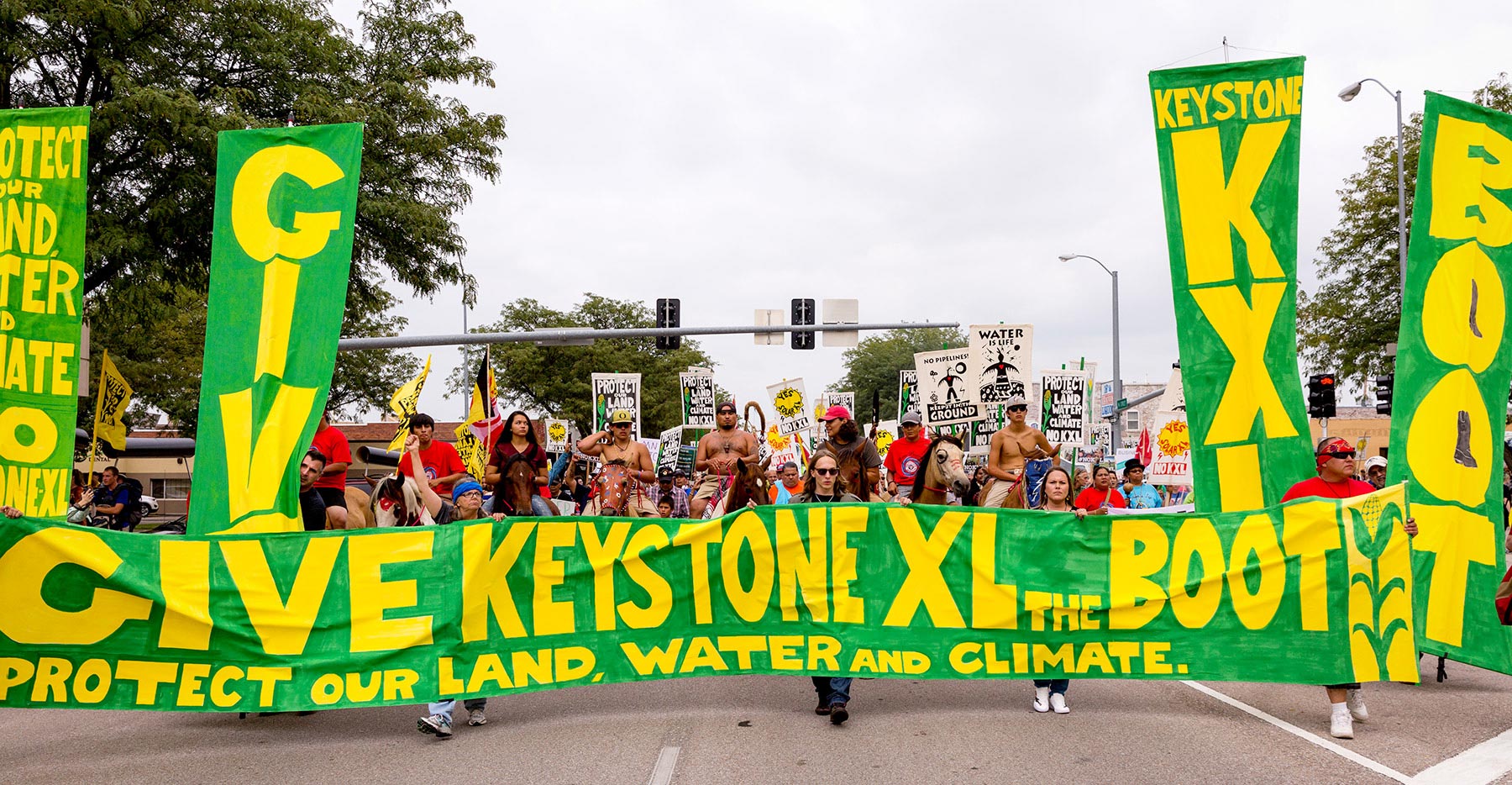
The Unlikely Alliance That Could Stop Keystone and Transform the Democratic Party
Natives and ranchers are teaming up to save their water and land from corporate takeover.
Above: Native horseback riders lead the “March to Give Keystone XL the Boot” on August 6 through downtown Lincoln, Neb.
September 26, 2017 | October Cover Story Issue
Officially, the fate of one of the most high-profile corporate infrastructure projects in a generation now rests with an obscure regulatory body in one of this country’s most sparsely populated states: Nebraska’s Public Service Commission. Unofficially, the homegrown movement that blocked the Keystone XL pipeline once before is ready to stop it again—even if commissioners give it a green light.
A ruling isn’t expected until November, but after the commission’s latest hearings adjourned August 10, Jane Kleeb, one of the pipeline’s highest-profile opponents and now the chair of the Nebraska Democratic Party—flanked by landowners who live along its proposed route—made an unconditional pledge: “Standing Rock was a dress rehearsal compared to what this will be. We are not going to let an inch of foreign steel touch Nebraska soil.”
A gauntlet had been thrown.
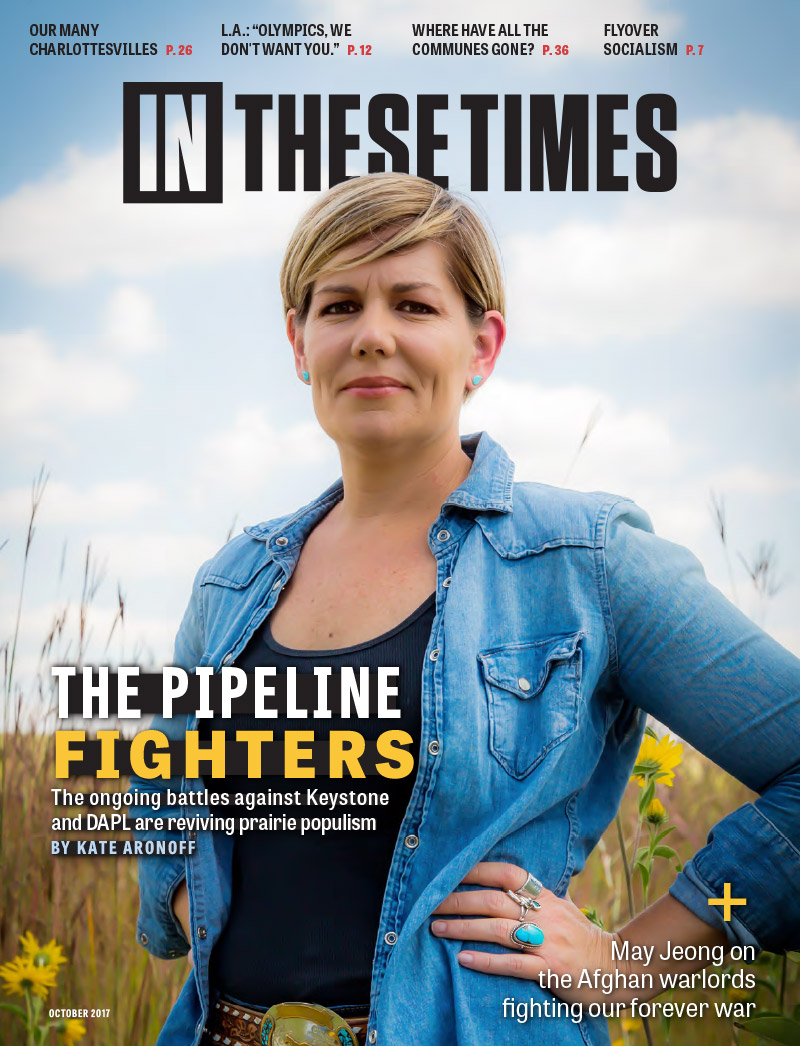
From the October issue of In These Times.
It’s unclear whether TransCanada even wants to build the pipeline, with the price of crude oil falling. But the White House has put its clout behind finishing both Keystone XL and the Dakota Access Pipeline (DAPL)—the one that sparked last year’s historic encampments at Standing Rock.
Whatever the fate of the pipelines, their political opposition is poised to endure. Pipeline resistance—initially energized around issues of land and water rights—has sparked a progressive populism in red-state America, defined by unlikely multi-racial alliances and an excitement about winning electoral power. That populism may just hold the key to transforming the Democratic Party into a force that fights against corporate power and for working people—and wins.
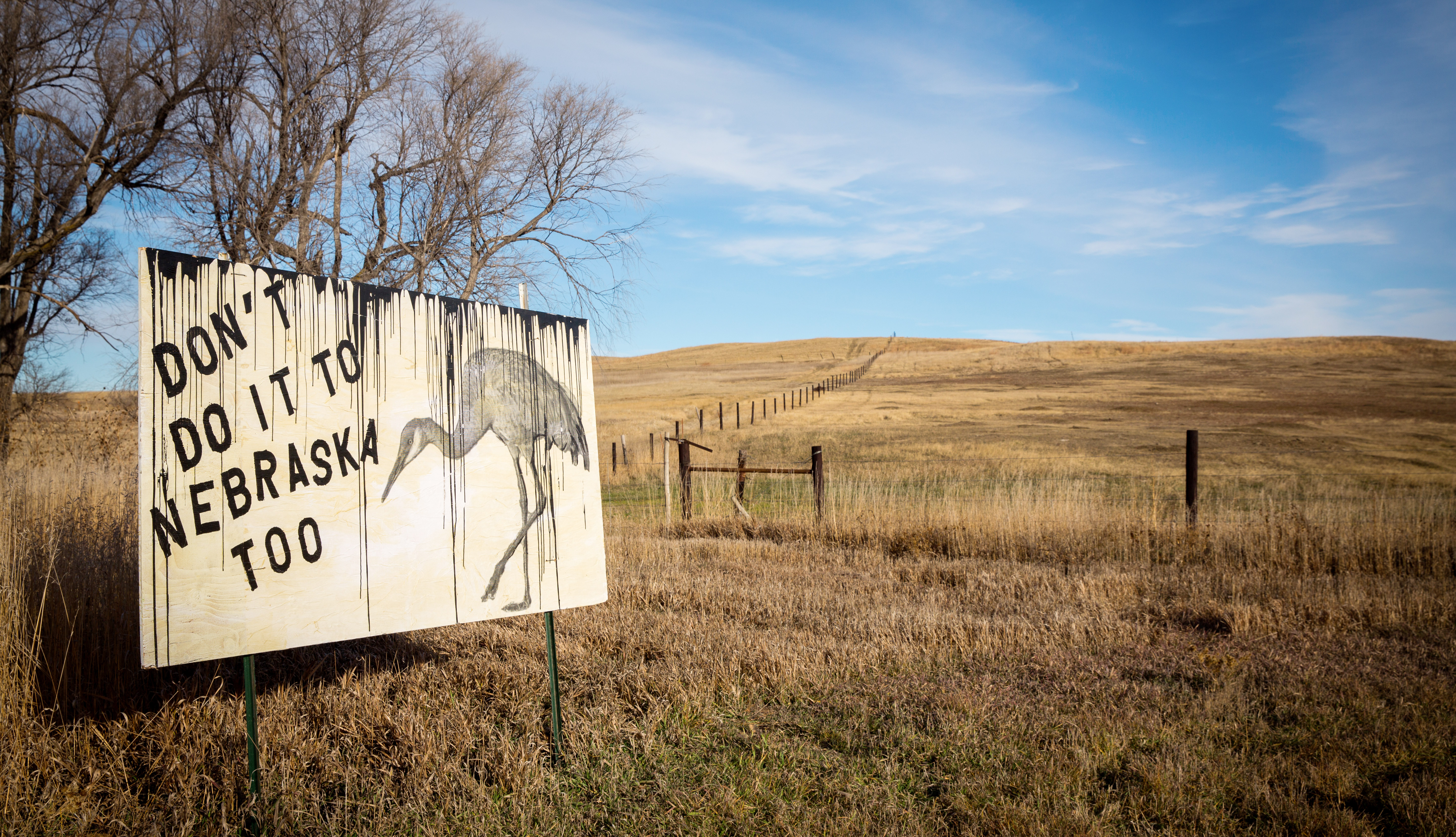
water is life
Faith Spotted Eagle was born in 1948 along the Missouri River. One of her first memories is of watching her relatives in the Yankton Sioux (Ihanktonwan Dakota Oyate) tribe flee their land in advance of a man-made flood. They were standing on one of 552 square miles of reservation land being inundated by order of Congress under the Pick-Sloan Plan, which authorized the Army Corps of Engineers and a slew of private contractors to take over large swaths of the Missouri River Valley. They were making way for what are now five of the world’s largest earthen dams—dams that displaced an estimated 3,538 Native people via eminent domain. Spotted Eagle, who lives in South Dakota, says, “My complete community was essentially killed.”
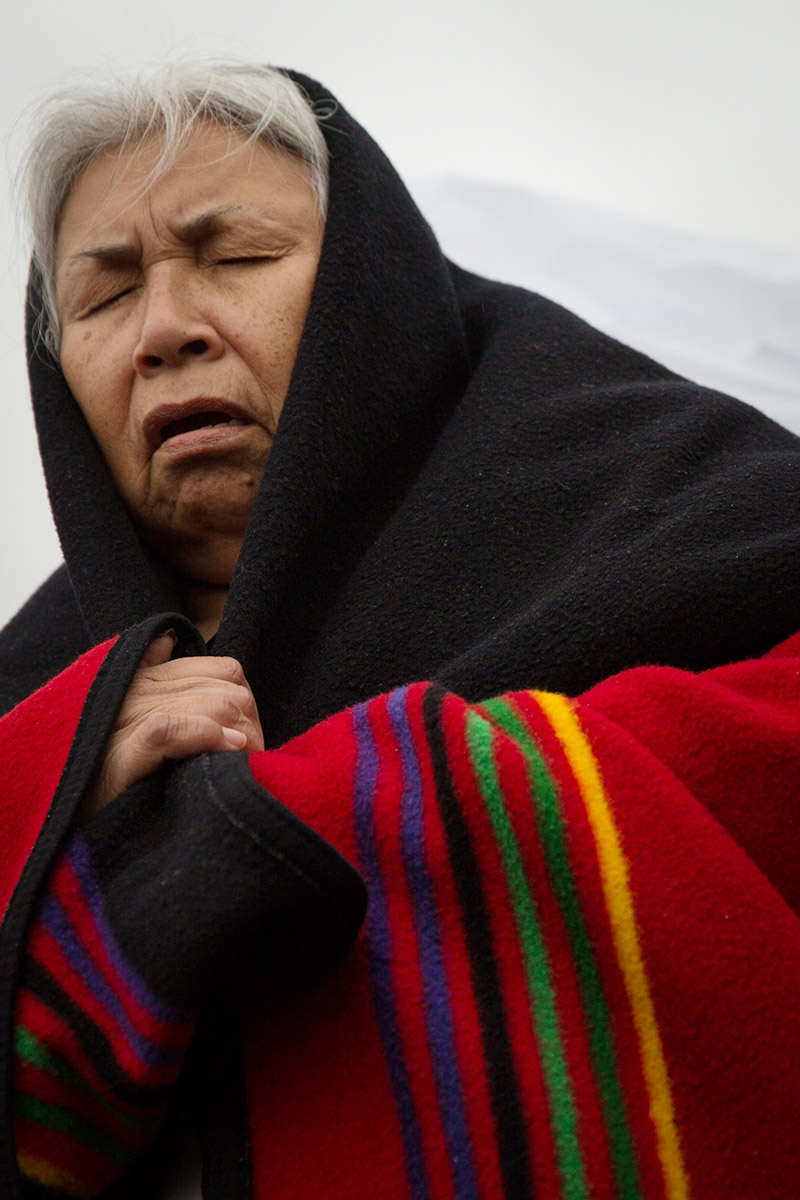
Faith Spotted Eagle, a member of the Yankton Sioux, guides a group prayer April 18, 2013, on the family farm of Keystone fighter Jim Tarnick near Fullerton, Neb.
Spotted Eagle has emerged as one of the nation’s most prominent anti-pipeline organizers, nurturing the growth of alliances between Native tribes and groups historically at odds with Plains Indians over land and resources: white farmers and ranchers.
Today’s water politics in the High Plains are no less toxic than in Spotted Eagle’s youth. The company behind DAPL, which initially considered routing the pipeline across the Missouri River just north of the the 92-percent-white city of Bismarck, rerouted it through land provisioned for the Sioux by the 1851 and 1868 Fort Laramie Treaties, in part to protect Bismarck’s water supply. The now-operational pipeline instead crosses the Missouri River just upstream from where the reservation of the Standing Rock Sioux Tribe gets its drinking water. The Keystone XL pipeline, too, would cross over treaty land and the Missouri, as well as the massive underground Ogallala Aquifer, which provides 81 percent of the water used in the arid High Plains.
One of the biggest problems with all this is that pipelines tend to leak. There have been almost 9,000 significant pipeline incidents—explosions, leaks and spills—over the last 30 years in the United States, involving thousands of temporary evacuations and hundreds of human deaths. DAPL sprang two leaks before it even came online, although both were quickly contained.
Water contamination is of special concern for the tribes. If any one phrase captures what has animated the battles against Keystone XL and DAPL, it’s Mni Wiconi, Lakota for “water is life.”
“It’s the first medicine,” Spotted Eagle says. “When a baby is being born there’s water, and two-thirds of our bodies are water, which is a reflection of Mother Earth.”
Water infrastructure in the rural areas on and around reservations tends to be either drastically underfunded or nonexistent. According to a 2013 report from the Indian Health Service, a federal agency, 7.5 percent of Native American and Alaska Native homes lack safe drinking water. Combined with reservations’ stunningly high poverty rates (43.2 percent at Standing Rock), the destruction of the area’s main source of drinking water could provoke serious health crises.
Water quality is also a serious concern for farmers and ranchers, whose livelihoods depend on clean water for crops and cattle. Fifty-four percent of land on the Ogallala Aquifer is used for agriculture, including the several-hundred-mile stretch through Nebraska and South Dakota where many TransCanada opponents live. Farmer Art Tanderup, an anti-pipeline advocate whose land Keystone would cross, explains that the farmland on the Ogallala is “basically a sponge,” making it exceptionally vulnerable.
“It would be devastating,” he says of the possibility of a major spill. “We would not be able to have drinking water here ... or to farm or build up topsoil.”
Like many farmers and ranchers, Tanderup first encountered TransCanada when company representatives turned up on his doorstep, offering a five-figure sum to lay pipe under his land. (Keystone XL and DAPL are both underground pipeline projects.) To hear many landowners tell it, these interactions quickly turned sour and company representatives moved to start eminent domain proceedings against those who didn’t accept their offers. Alongside fears of water contamination, many in the area objected out of principle, seeing an encroachment upon their property rights. In response, several landowners—working with the statewide non-profit Bold Nebraska—filed lawsuits to halt the TransCanada’s eminent domain proceedings against them. TransCanada dropped the proceedings in late 2015, about a month before the Obama administration blocked the pipeline.
Spotted Eagle recalls meetings in 2013 about Keystone XL between the tribes and landowners. “We watched their emotional trauma of their land being taken,” she says. “That’s very familiar to us. They were facing eminent domain. I think a lot of people had never dealt with that in America. When we saw that happening, the immediate thing that came to our mind was that, because of their pain, these could be allies.”
As a result of those experiences, Spotted Eagle and several other organizers with the Yankton Sioux revived the Cowboy Indian Alliance, taking on the mantle of a 1980s coalition against uranium mining and munitions testing in South Dakota’s Black Hills. Since reforming, the alliance has been a leader in the Keystone fight. In 2014, farmers and tribal elders rode side-by-side on horseback to the National Mall, where they set up a weeklong encampment.

FROM pipelines TO BALLOTS
The new energy on the ground in the Great Plains isn’t stopping with opposition to pipelines. In states across the region, coalitions that formed to challenge the oil industry are now pushing to take local offices.
In Nebraska, battling pipelines has primed people around the state for a broader set of progressive ideas, while providing invaluable information about what works and what doesn’t outside the more liberal Lincoln and Omaha.
One of the most public faces of the resistance against TransCanada in Nebraska now happens to run the state’s Democratic Party. Elected in June 2016, Jane Kleeb has spent the last several years driving around the Cornhusker State convincing farmers and ranchers, many of them Republicans, to join what’s become one of this century’s biggest anti-corporate campaigns.
Jane Kleeb talks about the unlikely alliance of farmers and indigenous tribes that is taking on the oil industry and fighting for climate justice. (Video produced by BillMoyers.com)
Nebraska has had Republican governors since 1999. Since 1995, it has only once elected a Democrat to Congress. Kleeb founded the advocacy group Bold Nebraska in 2010, and knows what it means to organize uphill in a red state.
“Generally, they hate big,” Kleeb says of the landowners she’s met through the course of the Keystone fight. “That’s big government, but that’s also big corporations that want to take their land through eminent domain, or big agriculture.”
Keystone, Kleeb says, “was the first issue that they saw up close and personal that the politicians in office weren’t representing their best interest and were turning their back on a fundamental principle of conservatism: protecting individual property rights.” Nebraska’s ruling GOP had been a consistent booster of the project. TransCanada spent nearly a million dollars lobbying in Nebraska over the course of their push to build Keystone XL.
An anti-establishment ethos is by no means new to Nebraska. In the early 1890s, the People’s Party—the Populists—swept through the Great Plains and the Southern Black Belt. In 1892, the party’s Omaha Platform included calls to nationalize the railroads, telegraph lines and phone lines, as well as for the then-utopian idea of an eight-hour workday. Nebraska was the epicenter of the People’s Party’s agrarian populism, electing two Populist governors and seven congressmen. Part of that wave was Democrat William Jennings Bryan, who rallied supporters against “Eastern elites” who made it harder for farmers to bring their crops to market through high-interest loans and monopoly control of the railroads.
Farming is the core of Nebraskan pride, and today’s revived progressivism has been primed by increasing corporate domination over the agricultural sector. That’s also what has led several of the farmers who In These Times spoke with to opt out of contracts with the big growers that dominate the state, like Cargill and ConAgra.
Among them is Jim Knopik, a farmer who lives just west of Fullerton and has been deeply involved in the Keystone fight with Bold Nebraska.
“It’s the corporations versus individuals and small producers,” Knopik says. “You have your big operators who are running four to five thousand-acre farms now under one manager.”
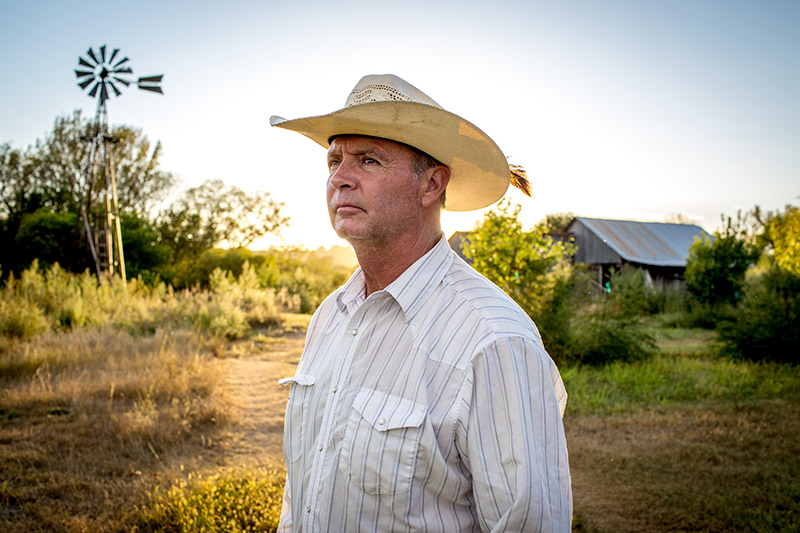
Nebraska farmer Rick Hammond built a solar- and wind-powered barn in the path of Keystone XL.
That TransCanada would mistreat farmers isn’t all that surprising to those who’ve watched Big Ag take over their industry. It’s also why Knopik and many other rural Nebraskans are fans of Bernie Sanders, who won the state’s Democratic Primary.
“He thinks about people as a whole, not just a selected few,” Knopik says. “That’s what elected officials are supposed to do.” His face lights up describing a campaign rally for Sanders he attended in Lincoln, where 1,500 people were turned away because one of the city’s largest auditoriums hit capacity.
Kleeb notes one major challenge for the Nebraska Democratic Party (NDP) is the national party’s disinvestment from red states and state parties in general. She says this not just as the leader of the NDP, but as a member of both the Democratic National Committee’s Unity Reform Commission and the board of directors for Our Revolution, which grew out of Sanders’ campaign.
“Because we had president Obama in office for eight years, people got very comfortable with policies and culture and methods coming from the White House,” Kleeb says. “And it completely then starved all of the basic infrastructure that actually wins elections at the local level.”
While the NDP is backing Democrat Jane Raybould in her challenge to incumbent Sen. Deb Fischer (R), much of the party’s rebuilding efforts consist of running candidates for hyper-local offices, in many cases for the kinds of unsexy positions pipeline fighters have become well acquainted with. These include seats on the Nebraska Public Service Commission, now deliberating on Keystone’s fate. Virtually anyone who’s been deeply involved in anti-Keystone efforts can rattle off intricate details about Nebraska’s regulatory procedures. As the party attempts to regain lost ground, that knowledge could come in handy.
“I’ve been in politics now for 20 years, and this is the first time I feel like people are coming out of the woodwork to say, ‘I want to run,’ ” Kleeb says. “One of the first things we tell new people is, let’s look at Natural Resource District offices. Let’s look at public power districts,” which control Nebraska’s electric utilities. “Let’s look at the Public Service Commission. Immediately people think of Congress, governor and state legislature. If you care about energy and climate change and water, though, it’s these bodies that have real power.”
The NDP is looking to mount candidates for the two Public Service Commission seats up for grabs in 2018. While highly specialized, these positions are key to determining everything from water quality standards to where towns get their power.
Though Democrats seem to agree they need a 50-state strategy that operates between presidential election cycles, the realities of getting there are thornier. Kleeb laments, “The mistake that Democrats and progressives have made over the last 20 years is that they have written off rural communities as racist and not progressive.”
Following Trump’s election, progressives have focused on building “the resistance” in solidly blue states like New York and California. This excitement tends to ignore the fact that tens of millions of potential progressive voters are scattered throughout so-called Trump country, too—often in places with legacies of anti-establishment politics that don’t fit cleanly on the left-right spectrum of Beltway politicos. Indeed, the priorities of today’s new strain of rural populism, such as rallying for property rights and against foreign corporations, might chafe against some variants of coastal leftism. In this context, any one-size-fits-all approach to beating the GOP may well be dead on arrival.
decolonizing government
Nebraska is one of just three states that has elected Native leadership to the Democratic National Committee. Veteran Winnabego activist Frank LaMere is second-in-command at the NDP, elected on the same slate as Kleeb.
Current Native Caucus chair Mechelle Sky Walker says the showdown at Standing Rock has been more of a galvanizing force in Native communities than the one over Keystone XL. “It was totally different,” Sky Walker says. “Standing Rock was fully Native-based. It was one tribe standing up to an oil company, and they asked for help.” She made two supply runs to the North Dakota encampment before water protectors were evicted from the site in February, and helped organize rallies in support at home in Lincoln.
Aside from the myriad structural barriers to voting on reservations, Native voters are understandably skeptical about electoral politics. “There’s a lot of distrust with the state,” Sky Walker says, relating her experience working for the Nebraska state government. “If you look at historical trauma, there’s no reason in hell why they should trust you.” Key to overcoming that, she argues, is taking the time to actually build in-person relationships on reservations.
In South Dakota, veterans of the Standing Rock and Keystone XL fights are figuring out how to translate that energy into the ballot box. Chas Jewett, a Lakota woman and longtime climate organizer, has been working with Sanders delegate Allison Renville to found a PAC called Dakotas For America, aimed at increasing voter turnout in Indian Country and helping Native candidates run.
“It wasn’t just the most radical of us who protest everything [at Standing Rock]. It was institutional, it was professional people in our communities,” she says. Jewett tells me she’s seen a lot of interest in people running for office in the months since the eviction. “We’re trying to encourage our people to jump into races for local and statewide offices, not just tribal offices,” she says. “The ideas that have kept [Native people] alive for the last 500 years can help us all transition to a more earth-friendly nation.”
For her, elections and voter turnout efforts are about much more than pipelines or specific policies. They’re part of a larger push to upend centuries of brutal discrimination. She says, “We can start to think about what running a decolonized nation in 2017 looks like.”
“I love America. I think what we’ve got here is something good and it has potential, but it’s not a reality. If you’re comfortable in America, you’re part of the problem,” she told In These Times over the phone in mid-August. News had just broken that a counter-protester had been killed at the Unite The Right rally in Charlottesville, Va. “We have two options: We can come together and see what justice looks like in America, and have a hard conversation. Or we continue as-is. In South Dakota, we’re trying to have a better conversation.” 
is a writing fellow at In These Times covering the politics of climate change, the White House transition and the resistance to Trump’s agenda. Follow her on Twitter @katearonoff
Above: Keystone Pipeline opponent Jane Kleeb is now chair of the Nebraska Democratic Party.
Want to stay up to date with the latest news on the climate movement? Subscribe to the free In These Times weekly newsletter:
